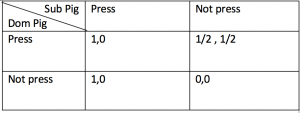Boxed Pig Game and Setting Up Shops
In the domain of Game Theory, there is another classic example that was not mentioned in the lecture: Boxed Pig Game. In this game, there are two pigs in a box. One is dominant and the other one is subordinate. And there is a lever on one side of the box and a device that can provide food to the pigs on the other side. The device produces food only if the pigs press the lever. If only one pig presses the lever, the other pig will get the chance to run to the food earlier. Because the dominant pig is bigger than the subordinate pig, it eats faster too. If the subordinate pig chooses to press the lever, the dominant pig will eat all the food before the subordinate pig can reach the device. But if it’s the dominant pig who press the lever, it can get half of the food by pushing the subordinate pig away from the device after it arrives at the device.
As the table above shows, the subordinate pig will always choose to not press. If the dominant pig wants to get food, it will press the lever and the subordinate pig will wait beside the device. In this way, the subordinate pig can maximize its benefits.
When I was a kid, I was always wondering why do shops that are similar always concentrate in the same area. For example: if there is a McDonald beside a crossroad, there will also be a KFC and some other fast-food restaurants lying beside that crossroad. This phenomenon does not only happen in the food industry. Here is another example: In China, there will always exist a street near shopping malls where people can see a lot of small shops selling cheap garments. I used to ask my mother why do they stay near the shopping mall:” Who will buy things in those small shops when there is a shopping mall existing nearby? And why do they all gather in this area? Won’t a shop attract more customers if it’s the only shop on the street?” But after reading about the boxed pigs game, I can easily understand why small shops choose to gather together can stay near the shopping mall. The shopping mall is the ‘dominant pig’ and small shops are ‘subordinate pigs’. The area where shopping malls stands will attract more customers. Although small shops can only attract a small part of the customers, they can at least earn something. But if a small shop decides to stay in a separate area, it might not be able to attract any customers because it is not as influential as the big shopping mall.
source: https://managerialecon.blogspot.com/2011/11/john-mcmillans-rational-pigs-puzzle.html

